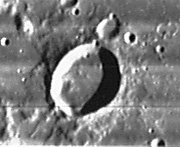Clausius
Contents
Clausius
|
Lat: 36.9°S, Long: 43.8°W, Diam: 24 km, Depth: 2.26 km, Rükl: 62 |
Images
LPOD Photo Gallery Lunar Orbiter Images Apollo Images
The 35th item in C.A.Wood's list of Concentric Craters (1978) is the one west-northwest of Clausius and northwest of Clausius E. It is noticeable on the Hi-Res scan of Lunar Orbiter 4's photograph LOIV-148-h3. Clausius itself is depicted near the frame's lower margin.
Research: Danny Caes
Maps
(LAC zone 110B3) LAC map Geologic map
Description
This is an example of craters that are large enough in diameter to have complex crater morphology - terraces and central peaks - but don't. The walls are fairly sharp with only a few later impact scars indicating a relatively youthful age. The floor is dark at full Moon indicating that it is occupied by mare basalt. So the crater was modified by rise of magma up fractured crust under it. But it doesn't appear that the lava has covered a peak or terraces so the present walls are probably as formed. It has been speculated by Don Wilhelms that craters like this may be impact basin secondaries, but we don' know with certainty. - tychocrater Jun 30, 2007
Description: Elger
(IAU Directions) CLAUSIUS.--A small bright ring-plain in an isolated position N.E. of Schickard, with a crater both on its N. and S. rim, and a faint central hill.
Description: Wikipedia
Additional Information
- Depth data from Kurt Fisher database
- Westfall, 2000: 2.26 km
- Viscardy, 1985: 2.4 km
- Cherrington, 1969: 1.79 km
- Concentric Crater northwest of Clausius E.
Nomenclature
Rudolf Julius Emanuel Clausius (January 2, 1822 – August 24, 1888), was a German physicist and mathematician and is considered one of the central founders of the science of thermodynamics. His most important paper, on the mechanical theory of heat, published in 1850, first stated the basic ideas of the second law of thermodynamics. In 1865 he introduced the concept of entropy.
LPOD Articles
Bibliography
